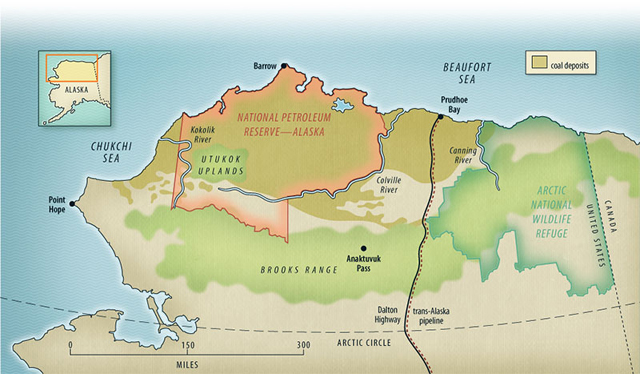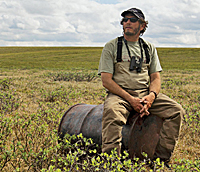sierraclub.org - sierra magazine - november/december 2010 - arctic coal, arctic melting

Map: Peter and Maria Hoey
Not far beneath the permafrost of the Alaskan Arctic lies one of the largest coal deposits in the world. Exactly how large is a matter of debate, but the U.S. Geological Survey has identified a "hypothetical resource" of up to 3.5 trillion tons--as much as all the known coal reserves in the Lower 48 put together. Thus far the logistical difficulties of mining and transportation above the Arctic Circle have held development at bay. There are no railroads in the frozen north, and the ports on the Chukchi Sea have historically been icebound for nine months a year.
Coal mining and climate change, however, are mutually reinforcing. Coal burning is raising global temperatures, most dramatically in Arctic regions. A warmer Arctic means a longer shipping season in the Chukchi Sea, making coal export more economical.
 Dan Ritzman's goal: Keep the coal in the ground. | Photo by Brian O'Neill
Dan Ritzman's goal: Keep the coal in the ground. | Photo by Brian O'Neill
In 2006, Australia-based BHP Billiton, the world's largest mining company, initiated coal exploration on land controlled by the Native-owned Arctic Slope Regional Corporation. BHP abandoned the project in 2009 as uneconomical, but now a new company is prospecting for bituminous coal—the hottest-burning, most valuable variety—on state land near Anaktuvuk Pass, conveniently not far from the Dalton Highway. The Sierra Club is appealing Alaska's approval of the prospecting permit, but as Club regional representative Dan Ritzman puts it, "the state of Alaska never met a project that rips stuff up that it didn't like."
To show Alaskan Native communities what coal development might mean for them, Club organizer Emily Fehrenbacher recently helped bring Louise Benally from the Black Mesa Water Coalition in Arizona to share her experiences in fighting Peabody Energy. (See "Homeland Security," July/August.) "These people have no mercy, and these people will not fix problems they create," Benally said.
The Sierra Club's opportunities to block coal development on Native or state land are limited. Federal lands, however, are a different matter. The coal-rich Utukok Uplands is a four-million-acre chunk of the National Petroleum Reserve—Alaska; it's also the calving grounds of the state's largest caribou herd. The Interior Department is developing a new management plan for the reserve, and the Sierra Club's Beyond Coal campaign is pushing for the Utukok Uplands to be protected—meaning a permanent ban on mineral development. That "protects the caribou's calving grounds and keeps climate-destroying coal in the ground," says Ritzman.
To register your comment, go to chillthedrills.org. —Paul Rauber